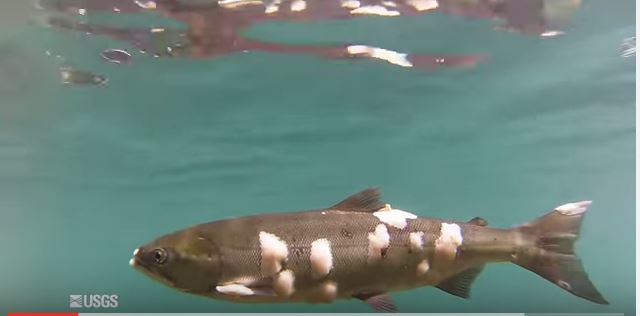forum
library
tutorial
contact

Hot Water Poses Ongoing Threat to
Columbia River Salmon, Groups Say
by Becky Kramer
Spokesman-Review, August 15, 2016
|
the film forum library tutorial contact |

|
Hot Water Poses Ongoing Threat to
by Becky Kramer
|
 Hot water is killing salmon in the reservoirs behind Columbia and Snake river dams, and the federal government must take action to prevent future die-offs of the Northwest's iconic fish, environmental groups say.
Hot water is killing salmon in the reservoirs behind Columbia and Snake river dams, and the federal government must take action to prevent future die-offs of the Northwest's iconic fish, environmental groups say.
Last year, more than 250,000 adult sockeye salmon perished when temperatures in some reservoirs hit 72 degrees by mid-July. Nearly all of the 4,000 sockeye returning to spawn in Idaho's Stanley Basin were killed.
"For the people of Idaho, this is a huge deal,' said Kevin Lewis, executive director of Idaho Rivers United. "Sockeye salmon are a special species to us, and they're already imperiled. To have virtually the entire run killed from hot water is unacceptable.'
A coalition of salmon advocates on Monday filed a 60-day notice of intent to sue the U.S. Environmental Protection Agency over the water temperature. If the agency doesn't develop a plan for addressing high temperatures within two months, or reach a settlement, the groups will proceed to a lawsuit under the federal Clean Water Act.
"I think 2015 was an ugly glimpse into the future of what the Columbia and Snake rivers could look like under climate change,' said Miles Johnson, an attorney for the Columbia Riverkeeper. "We need a comprehensive plan to deal with dams' impacts on water temperature, or we may be telling our kids stories about salmon instead of teaching them to fish.'
Dams heat up water temperatures by creating large, slackwater reservoirs that act like "solar panels' for absorbing radiant energy, Lewis said. Water temperatures above 68 degrees are dangerous for salmon.
Adult sockeye are particularly vulnerable because they migrate back to spawning grounds during the hottest part of summer. Spring and fall chinook migrations typically occur before and after the temperatures peak.
Last year was the warmest on record globally, with drought and early melting of snowpack affecting Northwest rivers. Even though 2016 has been a return to more typical weather patterns in the Northwest, some Columbia and Snake reservoirs still are recording temperatures of 70 degrees. It's the third consecutive year of record-high water temperatures in the rivers, salmon advocates say.
"Salmon are used to living in much colder water; it would be like us being outside on a 110-degree day with a fur coat on,' Lewis said. "Every year, we're flirting with disaster. It doesn't take much to push us over the norm.'
The waters of the Columbia and Snake rivers are listed by Washington, Oregon and Idaho as too hot to protect returning adult salmon in the summer and fall. Back in 2000, both Washington and Oregon asked the EPA to develop a legally enforceable plan to address water warmth in the river system.
The EPA released a draft plan in 2003 identifying dams as the primary cause of higher river temperatures.
However, the plan "was never finalized. It got put on a shelf,' said Brett VandenHeuvel, the Columbia Riverkeeper's executive director.
The U.S. Army Corps of Engineers, which operates many of the federal dams on the Columbia and Snake, "derailed the process,' Johnson said. The Army Corps wanted to address the warm water through an alternate plan, but "essentially, nothing has happened for the last 15 years,' he said.
An EPA spokesman declined to respond, saying the agency's policy is not to comment on pending litigation. The Army Corps also declined to comment Monday.
Water temperatures in Lake Roosevelt, the 150-mile-long reservoir behind Grand Coulee Dam, are up to 10 degrees warmer in late fall than pre-dam conditions, the draft EPA report said. In the Lower Snake River, water temperatures in four reservoirs are each 1 to 2 degrees warmer than they were before the dams were built, Johnson said.
The warming has a cumulative effect on the Lower Snake, he said. The water gets progressively warmer as it moves through each reservoir, which affects salmon migration, he said. The Snake also delivers the warm water to the Columbia, Johnson said.
Last year, many of the fish kills occurred in the Lower Columbia River, before the fish reached the John Day and McNary dams, he said.
"The main stem of the Columbia itself has pretty significant temperature problems, especially in warm years with low flow,' Johnson said. "EPA recognized that temperature is a problem for salmon and steelhead. We're hopeful that EPA will restart the planning process' to address the water temperature.
Other groups involved in the litigation include the Snake River Waterkeeper, the Pacific Coast Federation of Fishermen's Associations and the Institute for Fisheries Resources.
learn more on topics covered in the film
see the video
read the script
learn the songs
discussion forum
